Get the most out of your car by understanding these features. If you’re learning to drive in a modern car, or even if you’ve just bought a new car and haven’t read the instruction manual, look to see if you have any of these.
Vision and visibility
Photochromic (auto-dimming) mirror
 A photochromic mirror has a sensor that detects bright light coming through the rear window (e.g. a vehicle following you), and an electrical current which dims the glass. The majority of new cars come with these mirrors which replace the old-style mirror with a level underneath to change the angle. Some of the mirrors also contain other functions such as a built-in compass (as shown) or reversing camera image. You will usually find an on/off switch in the centre at the bottom of the mirror. Here is the original patent back in 1993.
A photochromic mirror has a sensor that detects bright light coming through the rear window (e.g. a vehicle following you), and an electrical current which dims the glass. The majority of new cars come with these mirrors which replace the old-style mirror with a level underneath to change the angle. Some of the mirrors also contain other functions such as a built-in compass (as shown) or reversing camera image. You will usually find an on/off switch in the centre at the bottom of the mirror. Here is the original patent back in 1993.
Fog lights
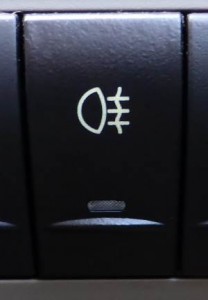 Your rear fog lights are one or two bright red lights (as bright as the brake lights) that should only be used when visibility is severely reduced, i.e. in fog. They can dazzle other drivers if you use them when visibility is good.
Your rear fog lights are one or two bright red lights (as bright as the brake lights) that should only be used when visibility is severely reduced, i.e. in fog. They can dazzle other drivers if you use them when visibility is good.
You might also have front fog lights and these could be activated by this switch, a separate switch, or be part of your headlights – it depends on the vehicle. Front fog lights are low-mounted lights which have a wide, flat beam that doesn’t get reflected back at you like full beam headlights would.
Full beam or main beam headlights
![]() Your main beam headlights are extremely bright lights used for seeing as far as possible at night. When you turn your headlights onto low beam it’s usual that the main beam headlights are activated by either pushing the stalk or wand forwards, or pulling it back until it clicks. Turning them off again is achieved by pulling the wand back.
Your main beam headlights are extremely bright lights used for seeing as far as possible at night. When you turn your headlights onto low beam it’s usual that the main beam headlights are activated by either pushing the stalk or wand forwards, or pulling it back until it clicks. Turning them off again is achieved by pulling the wand back.
Most new cars use the push forward for on method, and click back to turn off. If you pull the wand back this flashes the full beam headlights.
Don’t use full beam headlights when parked, when driving in fog, if a police officer is directing traffic, when there is other traffic coming towards you or when you are following another vehicle.
When the full beam headlights are on you’ll see a blue icon illuminated on your dashboard.
Intermittent/variable wipers
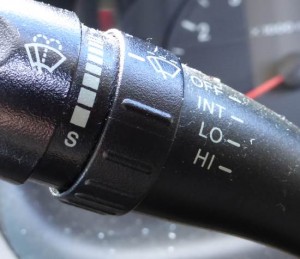 Your car will usually have between 3 and 8 settings for variable wiping speeds, or it will have automatic wipers which use a sensor on the windscreen to tell if it’s raining. At the fastest speed the wiping will be almost continuous, and at the slowest speed it will be once every few seconds which is good for light drizzle.
Your car will usually have between 3 and 8 settings for variable wiping speeds, or it will have automatic wipers which use a sensor on the windscreen to tell if it’s raining. At the fastest speed the wiping will be almost continuous, and at the slowest speed it will be once every few seconds which is good for light drizzle.
Remember to turn your wipers off if they are not needed as otherwise you are just wearing out the blades.
Windscreen washers
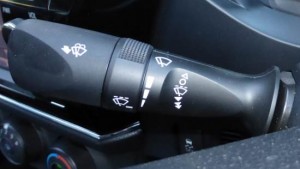 Your windscreen washers will spray water onto the windscreen so it can be cleaned by the wipers. In modern cars the two functions are connected – i.e. as soon as you activate the washers the wipers will come on; this isn’t the case for most older cars.
Your windscreen washers will spray water onto the windscreen so it can be cleaned by the wipers. In modern cars the two functions are connected – i.e. as soon as you activate the washers the wipers will come on; this isn’t the case for most older cars.
The spray will come from one or more nozzles either on the bonnet or mounted in the wipers themselves. These can get clogged with dirt and wax, and you can unblock them with a pin.
The wand shown here is pull back to activate the front washers and turn to activate the rear washer (usually there’s only one on the rear, centrally mounted at the top).
Some cars have headlight washers also synchronised to the windscreen washers. Here’s a video of how they work.
Adjustable steering wheel
Steering wheels on newer vehicles can be adjusted for height and (sometimes) rake, or how close or far away the steering wheel is from you.
To set the best steering wheel distance, adjust your seat so that it is comfortable, then put your hands through the steering wheel. Your wrists should rest on the edge of the centre of the wheel. This means that when you hold the wheel your arms will be slightly bent, and that gives you most control. You can bring the steering wheel closer if you want, but if it’s too close it will make the airbag a danger if it goes off.
The steering wheel adjustment lever is usually underneath or on the side of the steering column. This video shows how to adjust it in a Toyota Prius, and it’s a similar operation in most other cars.
Air conditioning and climate control
Recirculate
 Most modern cars have a recirculate button rather than the old-style slider to change the air flow from outside to inside. It’s used for:
Most modern cars have a recirculate button rather than the old-style slider to change the air flow from outside to inside. It’s used for:
- when you want to warm the interior of the car up quicker
- when you are in a polluted environment and don’t want to be breathing the smog, smoke or vehicle emissions that are outside.
It’s less effective when you want to clear fogged windows, unless you use the air conditioner, too. If you have it on recirculate without having the air conditioning on then it will fog the windows as your respiration gradually increases the humidity in the car and that water condenses on the cold windscreen.
Front demister
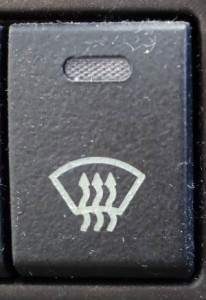 On newer cars this button will give instant full demisting power. It turns the air conditioning on, diverts the air to the windscreen and turns the fan on full. It’s a quick alternative to having to push the mode button, turn the fan up and turn the air con on, therefore improves safety (you don’t have to take your eyes off the road for as long)
On newer cars this button will give instant full demisting power. It turns the air conditioning on, diverts the air to the windscreen and turns the fan on full. It’s a quick alternative to having to push the mode button, turn the fan up and turn the air con on, therefore improves safety (you don’t have to take your eyes off the road for as long)
Rear demister
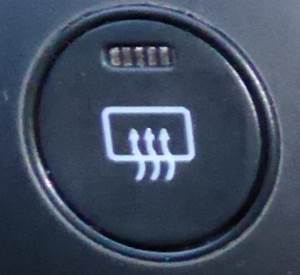 The rear demister button icon is a different shape so it doesn’t get confused with the front. The rear windscreen doesn’t have vents, it has wires running through the glass. When a current is passed through the wires the glass heats up and evaporates any condensation.
The rear demister button icon is a different shape so it doesn’t get confused with the front. The rear windscreen doesn’t have vents, it has wires running through the glass. When a current is passed through the wires the glass heats up and evaporates any condensation.
If your car is really prone to fogging up the windows perhaps you have a leak which you should investigate.
Temperature gauge
 The temperature gauge is useful because it can give you a clue about what dangers might be present. For example if it dips below 3 Celsius then there’s a chance that ice might start to form, and if it’s anything above 15 degrees then you shouldn’t be leaving pets in the car.
The temperature gauge is useful because it can give you a clue about what dangers might be present. For example if it dips below 3 Celsius then there’s a chance that ice might start to form, and if it’s anything above 15 degrees then you shouldn’t be leaving pets in the car.
Lock all doors
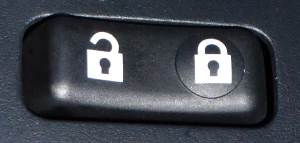 The lock all doors button is a safety button you can use if you are travelling through an area where you don’t feel safe. The button is usually located on the driver’s door. It’s also useful for vehicles that automatically lock above a certain speed as when you pull to a stop, all doors will be locked and you will need to open them to allow passengers in.
The lock all doors button is a safety button you can use if you are travelling through an area where you don’t feel safe. The button is usually located on the driver’s door. It’s also useful for vehicles that automatically lock above a certain speed as when you pull to a stop, all doors will be locked and you will need to open them to allow passengers in.
Trip computer
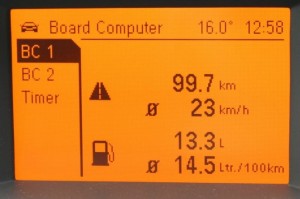 Trip computers can be simple A/B journey distances or they can be altogether more complex like the one pictured which gives distance, average speed, instantaneous fuel usage and average fuel usage.
Trip computers can be simple A/B journey distances or they can be altogether more complex like the one pictured which gives distance, average speed, instantaneous fuel usage and average fuel usage.
Trip computers are useful for long journeys as it allows you to estimate how long you have remaining in your journey, when you might need to get fuel, and how economical your driving is.
When you start a long journey, set one of the trip counters to zero and then you’ll know how far you have remaining.
